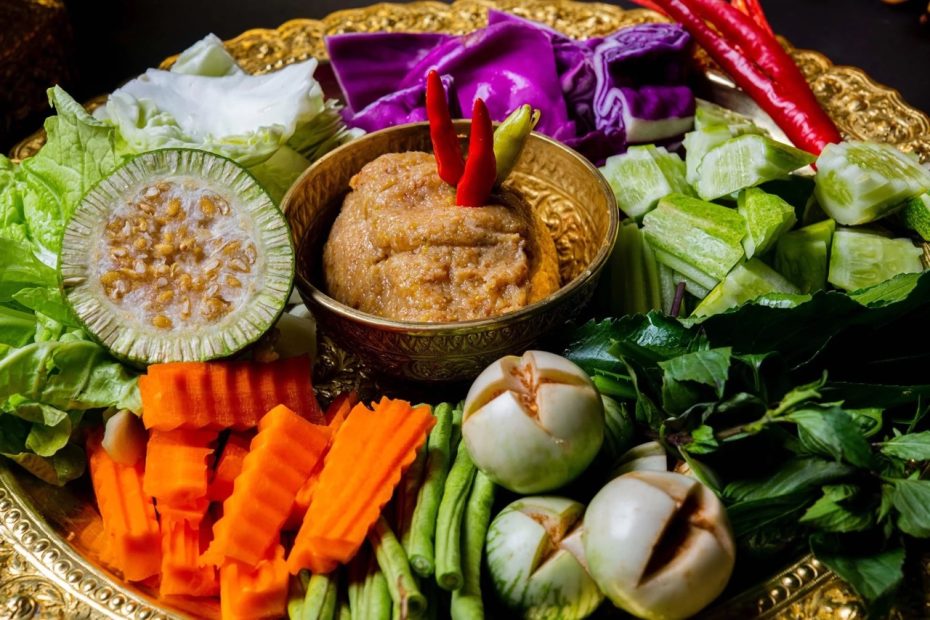Cambodian Prahok, often referred to as “Prahok” or “Pra-hok,” is a traditional fermented fish paste that holds significant cultural and culinary importance in Cambodian cuisine. It’s an essential ingredient in many Cambodian dishes and adds a unique and intense flavor to the food.
What is Cambodian Prahok Made of?
Prahok is made by fermenting fish, typically small freshwater fish like mudfish or snakehead fish, along with salt and rice bran or roasted rice. The mixture is traditionally stored in clay jars and left to ferment for several months, during which the fish undergoes a natural fermentation process. The end result is a strong-smelling, flavorful paste that can vary in texture from smooth to chunky, depending on the method of preparation.
This fermented fish paste serves as a key ingredient in numerous Cambodian recipes, adding depth and umami to dishes. It’s often used in stir-fries, soups, and dipping sauces. One popular dish that prominently features prahok is “Somlar Kari,” a flavorful soup made with vegetables and prahok.
Prahok’s distinct flavor and aroma might be an acquired taste for some due to its strong, pungent nature, but it’s an integral part of Cambodian culinary heritage and plays a crucial role in creating authentic Cambodian flavors.
What Is Prahok Used For?
Prahok, pronounced /ˈprɑːhʊk/ and known as ប្រហុក in Khmer, is a type of fermented fish paste that is salted and traditionally made using snakehead fish. It holds a significant place in Cambodian culinary practices, often utilized either as a seasoning to enhance flavor or as a condiment. This fish paste has its roots in the practice of preserving fish, particularly during periods when the availability of fresh fish was limited.
Why Prahok is So Popular in Cambodia?
Prahok is highly popular in Cambodia due to several cultural, historical, and culinary reasons:
- Ancient Origins: The practice of fermenting fish to create a preservation method dates back to ancient times. Cambodian communities developed this technique as a way to store fish for consumption during seasons of scarcity.
- Cultural Tradition: Prahok has been a part of Cambodian cuisine for centuries, deeply ingrained in the cultural fabric of the country. It has become a symbol of Cambodian identity and heritage, connecting generations through shared flavors and culinary practices.
- Resource Utilization: Cambodia’s landscape is rich in freshwater fish, making fish a readily available protein source. Prahok was developed as a way to preserve fish for consumption during seasons when fresh fish were scarce. This resourceful practice became a staple in Cambodian cuisine.
- Flavor Enhancement: Prahok’s unique fermentation process adds a robust umami flavor to dishes. It’s a versatile ingredient that enhances the taste of various recipes, imparting depth and complexity to Cambodian dishes.
- Preservation: Before the advent of modern refrigeration, Prahok was a practical means of preserving fish for extended periods. The fermentation process not only extended the shelf life of fish but also intensified its flavor, making it a valuable addition to meals.
- Culinary Diversity: Prahok contributes to the diversity of Cambodian cuisine by offering a distinctive and bold flavor profile. It can be used in a range of dishes, from soups and stews to dips and condiments, allowing for creativity and variety in cooking.
- Cultural Significance: Prahok is often associated with traditional Cambodian celebrations, gatherings, and ceremonies. It adds an element of authenticity and nostalgia to these occasions, making them feel truly Cambodian.
- National Pride: Prahok is considered a source of national pride and a way to distinguish Cambodian cuisine from that of neighboring countries. Its distinct taste sets Cambodian dishes apart and helps maintain its culinary identity.
- Regional Variations: Different regions within Cambodia have their own approaches to making and using prahok, resulting in a rich tapestry of flavors that reflect local tastes and preferences.
Overall, Prahok’s popularity in Cambodia can be attributed to its deep cultural roots, practical use for resource preservation, flavor enhancement, and its role in shaping the unique flavors and dishes of Cambodian cuisine.
Let’s check: Best Preserved Foods In Cambodia
Characteristics of Prahok
Prahok has a distinctive taste and smell that might be an acquired taste for those unfamiliar with it. Here’s a description of its taste and smell, as well as what it’s commonly eaten with:
Taste of Prahok: Prahok has a strong and intense umami flavor. It’s salty, savory, and often quite pungent. The taste can vary depending on the type of prahok and how it’s used in a dish. It’s commonly used as a seasoning agent to enhance the overall flavor of dishes, rather than being eaten on its own.
The smell of Prahok: The smell of prahok is equally distinctive. It’s known for its potent and sometimes overpowering aroma, which is a result of the fermentation process. The smell can be quite strong and might be off-putting to some, especially those who are not accustomed to it.
Eating Prahok: Prahok is used as an ingredient in a wide range of Cambodian dishes to add depth of flavor. It’s not typically eaten on its own due to its strong taste and smell. Instead, it’s incorporated into various recipes, such as:
- Dips: Prahok is often mixed with other ingredients like chilies, garlic, and lime juice to create flavorful dipping sauces. These sauces are commonly served with fresh vegetables, fruits, and grilled meats.
- Soups and Stews: Prahok is used as a seasoning in soups, stews, and curries. It imparts a rich and savory flavor to the broth and complements the other ingredients.
- Stir-fries: Prahok can be added to stir-fried dishes to provide a distinctive umami boost. It’s often paired with vegetables, meat, or seafood.
- Salads: Some Cambodian salads incorporate prahok for its unique flavor. Green mango salad, for example, can feature prahok as a seasoning.
- Condiments: Prahok can be mixed into condiments like “prahok sauce,” which is often used as a side dish to accompany meals.
- Grilled Dishes: Prahok can be used as a marinade or seasoning for grilled meats and seafood. The intense flavor of prahok adds depth to the grilled dishes.
- Fermented Dishes: Some Cambodian dishes use prahok as part of the fermentation process. “Prahok Ktiss” is an example where prahok is mixed with minced meat and other ingredients, then allowed to ferment before consumption.
Let’s check: Best Cambodian Foods You Must Try
Health benefits of prahok
- Protein Source: Prahok is made from fermented fish, which provides a source of protein that’s essential for muscle growth, repair, and overall body function.
- Probiotics and Gut Health: The fermentation process used to make prahok can introduce beneficial probiotics to the digestive system. These probiotics can support gut health and improve digestion.
- Mineral Content: Fermented fish products like prahok can potentially retain minerals like calcium and phosphorus, which are important for bone health.
However, there are some considerations to keep in mind:
- High Salt Content: Prahok is often salted during its preparation, which contributes to its preservation but also results in a high salt content. Excessive salt consumption can lead to high blood pressure, cardiovascular issues, and other health concerns.
- Strong Flavor and Aroma: Prahok has a strong and distinctive smell and taste, which might be an acquired taste for those unfamiliar with it. Some individuals might find its flavor overpowering.
- Sensitivity and Allergies: Individuals with fish allergies or sensitivities should avoid prahok, as it is made from fermented fish.
- Moderation: Due to the high salt content and strong flavor, prahok is best consumed in moderation. Using small amounts as a seasoning rather than a primary ingredient can help manage these aspects.
- Dietary Preferences: Whether you enjoy prahok or not depends on your personal tastes. If you’re new to prahok, it’s recommended to try it in small quantities to gauge your response.
- Consultation: If you have specific dietary concerns or health conditions, it’s advisable to consult with a healthcare professional or registered dietitian before significantly incorporating prahok into your diet.
How do Cambodians make Prahok?
Ingredients:
- Fresh small fish (such as mudfish or snakehead fish)
- Salt
- Rice bran or roasted rice (optional)
Steps:
- Cleaning and Preparation: The fish are cleaned, scaled, and gutted. They are often left whole, although some variations might involve removing the heads and entrails.
- Salting: The cleaned fish are then mixed with a generous amount of salt. The salt helps preserve the fish and kick-start the fermentation process. The fish are thoroughly coated with the salt.
- Layering: The salted fish are layered in large clay jars or wooden barrels. As each layer is added, more salt is sprinkled over the fish to ensure even distribution and preservation.
- Fermentation: If rice bran or roasted rice is used, it’s mixed with a portion of the salted fish to create a starter mixture. This starter is spread over the fish layers to introduce beneficial microbes that aid in the fermentation process. The jars are covered, and the fish are left to ferment for several months, typically ranging from a few months to a year.
- Checking and Turning: During the fermentation period, the fish might be checked periodically to ensure proper fermentation and quality. Some recipes call for turning the fish periodically to promote even fermentation.
- Completion: After the fermentation process is complete, the fish will have broken down into a paste-like consistency. The mixture is sometimes further processed by mashing or grinding to create a smoother texture.
- Storage: The finished prahok is stored in smaller containers for daily use. Traditionally, prahok is stored in clay pots, which help maintain its flavor and texture.
It’s important to note that the exact process and ingredients can vary based on regional preferences and family traditions. The use of rice bran or roasted rice, for example, can influence the flavor and texture of the final prahok.
Making prahok is a time-honored practice that requires knowledge and experience to achieve the desired flavor and quality. The strong aroma and taste of prahok might take some getting used to, but it plays a crucial role in Cambodian cuisine and culture.
Conclusion
In Cambodian cuisine, prahok is a key ingredient that adds depth and complexity to dishes, making it an essential part of the culinary tradition. It’s an ingredient that might take some time to appreciate, but it plays a vital role in creating authentic Cambodian flavors.
Remember that prahok is often used as a seasoning or ingredient rather than being eaten on its own. Its strong flavor can be overwhelming in large quantities, so start by using small amounts and gradually adjust to your taste preferences. Additionally, enjoying prahok in the context of Cambodian cuisine can provide a fuller understanding of its role and significance in the culinary culture.



